
The Santanoni Preserve was once a private estate of approximately 13,000 acres (53 km²) in the Adirondack Mountains, and now is the property of the State of New York, at Newcomb, New York.
The Order of Saint Basil the Great also known as the Basilian Order of Saint Josaphat is a Ukrainian/Belarusian monastic religious order of the Greek Catholic Churches that is present in many countries and that has its Mother House in Rome Santi Sergio e Bacco degli Ucraini. The order received approbation on August 20, 1631, and was based at the Holy Trinity monastery in Vilnius. Its monks, brothers, and priests work primarily with Ukrainian Catholics and are also present in other Greek-Catholic churches in central and eastern Europe.

Steepletop, also known as the Edna St. Vincent Millay House, was the farmhouse home of Pulitzer Prize-winning poet Edna St. Vincent Millay and her husband Eugene Jan Boissevain, in Austerlitz, New York, United States. Her former home and gardens are maintained by the Edna St. Vincent Millay Society, a nonprofit organization that also holds the rights to the poet's intellectual property. Steepletop was declared a National Historic Landmark on November 11, 1971.
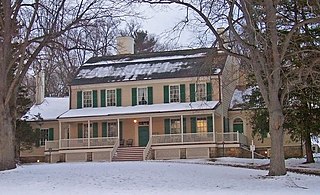
The John Jay Homestead State Historic Site is located at 400 Jay Street in Katonah, New York. The site preserves the 1787 home of statesman John Jay (1745–1829), one of the three authors of The Federalist Papers and the first Chief Justice of the United States. The property was designated a National Historic Landmark in 1981 for its association with Jay. The house is open year-round for tours.

Montgomery Place, now Bard College: The Montgomery Place Campus, near Barrytown, New York, United States, is an early 19th-century estate that has been designated a National Historic Landmark. It is also a contributing property to the Hudson River Historic District, itself a National Historic Landmark. It is a Federal-style house, with expansion designed by architect Alexander Jackson Davis. It reflects the tastes of a younger, post-Revolutionary generation of wealthy landowners in the Livingston family who were beginning to be influenced by French trends in home design, moving beyond the strictly English models exemplified by Clermont Manor a short distance up the Hudson River. It is the only Hudson Valley estate house from this era that survives intact, and Davis's only surviving neoclassical country house.

The Edward G. Acheson House is a historic house at 908 West Main St. in Monongahela, Washington County, Pennsylvania, United States. Probably built about 1870, it is notable as the home of Edward G. Acheson (1856-1931), the inventor of carborundum, and as the likely site of its invention. It was designated a National Historic Landmark in 1976.

Edward Brickell White, also known as E. B. White, was an architect in the United States. He was known for his Gothic Revival architecture and his use of Roman and Greek designs.

Park Lodge is a historic house in Methuen, Massachusetts. It is primarily noted for its association with industrialist and philanthropist Edward Searles whose Pine Lodge estate was nearby. Searles, a Methuen native who made a fortune in textiles and the railroad, made major contributions to the development of Methuen around the turn of the 20th century. This Craftsman style house, designed by Henry Vaughan and built in 1910, is a notable architectural element of Searles' legacy. The main block is a 2-1/2 story structure with a side-gable roof, which is extended to the left by a 1-1/2 story ell and to the front by a two-story projection. A shed-roof porch is in the crook to the left of this projection, and the main entrance is in the leftmost ell. The house is generally finished in stucco, with wooden shingles in the gable ends.
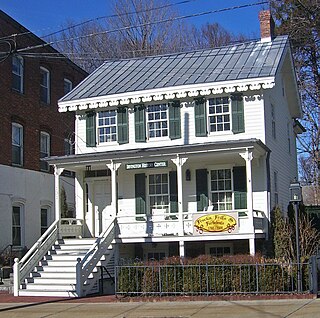
The McVickar House is located at 131 Main Street in Irvington, New York, United States. It is a wooden frame house built in the middle of the 19th century in the Greek Revival architectural style with some Picturesque decorative touches added later. In 2004 it was listed on the National Register of Historic Places.

The Fyler–Hotchkiss Estate, also known as the Hotchkiss-Fyler House Museum, is a historic house museum at 192 Main Street in Torrington, Connecticut. Operated by the Torrington Historical Society, its main house is a well-preserved and distinctive example of Chateauesque Victorian architecture. It is also significant for its association with Orsamus Fyler, a prominent local politician and businessman. The property was listed on the National Register of Historic Places in 2009.
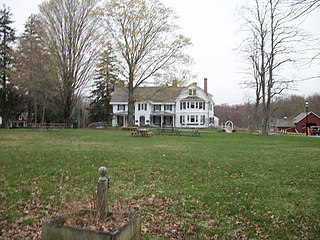
Smith Estate, also known as Longwood Estate - Smith House, is a historic estate located at Ridge in Suffolk County, New York. It is preserved and maintained by the Town of Brookhaven. The Longwood Estate is part of a huge parcel of land originally purchased by William "Tangier" Smith in the 17th century, which he called Manor St. George. The estate consists of a large, late 18th century main house, caretaker's cottage, a farm complex, the Smith family cemetery, and a small frame schoolhouse moved to the property in 1977.

The Dorilton is a luxury residential housing cooperative in Manhattan, New York City. Construction began in 1900 and was completed by 1902.

John Ellis Roosevelt Estate, also known as Meadow Croft, is a historic estate located at Sayville in Suffolk County, New York. The main house, roughly L-shaped, is composed of two distinct parts: the original farmhouse, built about 1850, and now the rear of the house; and the larger, more formal Colonial Revival mansion built 1891-1892 and set perpendicular to it. The original section is a two-story, rectangular farmhouse, sheathed in clapboard and surmounted by a gable roof. The 1891–92 section is a clapboarded, two-story structure with an elaborate facade with generous porch and surmounted by a steeply pitched, truncated hipped roof. Also on the property are contributing carriage house, equipment barn, garage, caretaker's cottage, swimming pool, storage hut, and archaeological sites. The property was purchased by Robert Barnwell Roosevelt (1829–1906) in 1873; his son John Ellis Roosevelt (1853–1939) commissioned the estate.

Chetolah, also known as the George Inness, Jr. Estate, is a historic estate located at Cragsmoor in Ulster County, New York.
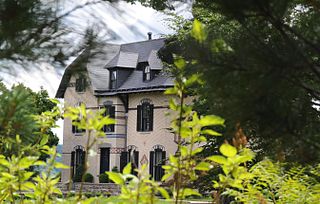
Neiderhurst is a historic estate located at Palisades in Rockland County, New York. The main estate house was built as a summer home between 1872 and 1874 in the High Victorian Gothic style. It is a two-story, "L" shaped residence surmounted by steep gable roofs. It was built by Winthrop S. Gilman, Jr. (1839–1923), son of Winthrop Sargent Gilman (1808–1884). Also on the property are a small observatory converted to a cote; Fern Lodge, built 1866, a residential outbuilding that was formerly the stables; a barn converted to residential use; a concrete pergola; and stone shed. The estate grounds retain a park-like quality.

Samson Fried Estate, also known as "Birch Hill," is a historic estate located at Severance in Essex County, New York. The estate has a Shingle Style main house, built as a summer residence in 1902, and nine contributing outbuildings. The main house is a large, two story rambling, roughly "L" shaped frame residence. It features hipped- and shed-roof dormers, four massive stone chimneys, second floor balconies, and a third story widow's walk. There is also a wide verandah around three sides of the house. The contributing buildings and structures include a garage, barn, hen house, tennis court, guest cottage, ice house, and well.
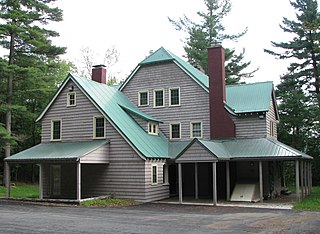
Larom-Welles Cottage is a historic cure cottage located at Saranac Lake in the town of North Elba, Essex and Franklin County, New York. It was built about 1905 and is a three-story wood-frame structure in the Shingle Style on a stone foundation and surmounted by a metal jerkin head gable roof. It has a two-story wing with a shed roof dormer. It has a two bay verandah and entrance porch with a second story sleeping porch. Also on the second floor is a cure porch. It was originally built for the priest of St. Lukes Episcopal Church, later the home of Dr. Edward Welles, a pioneer in thoracic surgery, who practiced at the Adirondack Cottage Sanitarium. The house has been converted to six units.
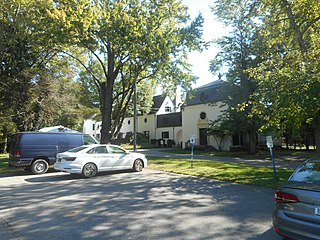
Benjamin Moore Estate, also known as Chelsea, is a historic estate located at Muttontown in Nassau County, New York. It was designed in 1923–1924 by architect William Adams Delano (1874–1960) for Benjamin Moore and Alexandra Emery. The manor house is an eclectic Chinese and French Renaissance style inspired dwelling. It is "U" shaped, two and one half stories high with hipped and gable roofs, covered with concrete block on a concrete foundation. The front facade features a steeply pitched roof, four large irregularly spaced chimneys, and a large brick tourelle with a conical roof. The property also has a contributing formal garden, gatehouse, picturesque roadways, garage, conservatory, octagonal gazebo, shed and tool house, and large open lawns.

Amelita Galli-Curci Estate, also known as Sul Monte, is a historic country estate located near Fleischmanns and straddling the boundaries of Delaware County and Ulster County, New York. It was designed by architect Harrie T. Lindeberg (1879–1959) as a country home for Italian operatic soprano Amelita Galli-Curci (1882–1963). The estate has seven contributing buildings and two contributing structures. The main house was built in 1922 and is a large, rambling two-story structure with multiple wings that wrap around a central courtyard. It is a wood frame building clad in variegated stone, stucco, and wood and sits on a concrete foundation. It features a series of massive, steeply pitched hipped and gabled cedar shingled roofs. Other contributing buildings and structures include the swimming pool, stone gateposts, sheds, caretaker's cottage, and dairy barn. Galli-Curci sold the estate in 1937.
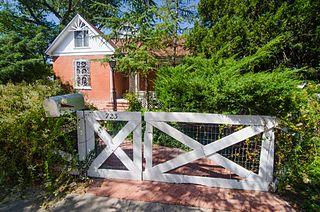
The Henry Mann House is a historic house in Albuquerque, New Mexico. It was built in 1905 by Henry Mann, who operated a market garden near Old Town with his brothers. The house cost $2,700 and the contractor was Wallace Hesselden, who also completed the John Pearce House the same year. The property was added to the New Mexico State Register of Cultural Properties in 1979 and the National Register of Historic Places in 1980.






















